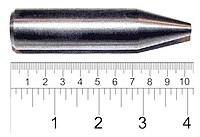
Photo from wikipedia
DNA damage caused by reactive oxygen species may result in genetic mutations or cell death. Base excision repair (BER) is the major pathway that repairs DNA oxidative damage in order… Click to show full abstract
DNA damage caused by reactive oxygen species may result in genetic mutations or cell death. Base excision repair (BER) is the major pathway that repairs DNA oxidative damage in order to maintain genomic integrity. In mammals, eleven DNA glycosylases have been reported to initiate BER, where each recognizes a few related DNA substrate lesions with some degree of overlapping specificity. 7,8-dihydro-8-oxoguanine (8-oxoG), one of the most abundant DNA oxidative lesions, is recognized and excised mainly by 8-oxoguanine DNA glycosylase 1 (OGG1). Further oxidation of 8-oxoG generates hydantoin lesions, which are recognized by NEIL glycosylases. Here, we demonstrate that NEIL1, and to a lesser extent NEIL2, can potentially function as backup BER enzymes for OGG1 upon pharmacological inhibition or depletion of OGG1. NEIL1 recruitment kinetics and chromatin binding after DNA damage induction increase in cells treated with OGG1 inhibitor TH5487 in a dose-dependent manner, whereas NEIL2 accumulation at DNA damage sites is prolonged following OGG1 inhibition. Furthermore, depletion of OGG1 results in increased retention of NEIL1 and NEIL2 at damaged chromatin. Importantly, oxidatively stressed NEIL1- or NEIL2-depleted cells show excessive genomic 8-oxoG lesions accumulation upon OGG1 inhibition, suggesting a prospective compensatory role for NEIL1 and NEIL2. Our study thus exemplifies possible backup mechanisms within the base excision repair pathway.
Journal Title: International Journal of Molecular Sciences
Year Published: 2021
Link to full text (if available)
Share on Social Media: Sign Up to like & get
recommendations!